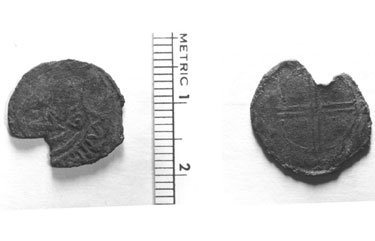The story that Guy Mellgren told about the curious silver coin began on the shores of Maine, where he met a stranger named Goddard. In the fall of 1956, Mellgren and Ed Runge, a pair of amateur archaeologists, had come in search of the most basic of coastal dig sites—a shell midden—when they happened onto a more unusual discovery.
Goddard had invited them to explore his shoreline property, and there, on a natural terrace about eight feet above the high tide line, they found stone chips, knives, and fire pits, along with an abundance of other unexpected artifacts. Each summer for many years, Mellgren and Runge returned to excavate the “Goddard Site,†with little help from professional archaeologists. In the second summer, they produced the coin.
For two decades, based on an analysis by a friend in a numismatics club, Mellgren described it as a coin minted in 12th-century England, and no one questioned that identification. The discovery should have been noteworthy—there’s no good explanation for how a medieval English coin could have crossed the Atlantic—but Mellgren never sought wider attention for the find. It was a curiosity to show off to friends and his son’s classmates, until, in 1978, a scrappy regional bulletin published a picture of the coin and an article titled, “Were the English the First to Discover America?â€
That picture found its way to a well-known London dealer, who recognized at once that the coin could not have come from England. Two weeks after Mellgren died, the coin’s reidentification swept into the news. It was a Norse penny, made between 1065 and 1093—evidence for Viking contact with North America centuries before Columbus.
All of sudden, experts from around the world began taking a careful look at the details of Mellgren’s story. Of many objects purported to prove a Viking presence in North America, only the artifacts painstakingly excavated at L’Anse aux Meadows, in Newfoundland, have stood up to investigation. The rest—the Beardmore relics, the Vinland Map, the notorious Kensington Rune Stone—are all considered hoaxes.
Since 1978, no one has questioned that the Mellgren coin is an authentic Norse penny, made in medieval Scandinavia. But 60 years after Mellgren’s find, archaeologists and numismatic experts are still asking how in the world this small, worn coin got to Maine.
Hat tip to Glenn Reynolds.






vanderleun
Get back to us when they discover a Norse coin-minting facility nearby.
One coin doth not a summer make.
bob sykes
Considering that L’Anse aux Meadows in Newfoundland is dated to 1000 AD, I fail to see what the mystery is. A coin minted in the 1100’s is clearly within the time range of Viking sailings.
I believe the site in Maine also contains large numbers of arrowheads and other paraphernalia, and it is likely it was a trading site.
Ted Clayton
Project Gutenberg, http://www.gutenberg.org/ has a nice raft of 19th C American archaeology books, in text & HTML format. That’s where this story begins.
But it’s not a flattering story, for our beloved Science. Recently, a now-solid female academic had to admit that she & her friends back in their college days, scratched some Runes into a woodland boulder, at the Kensington Runestone site. She quivered in righteous rage at her trog tormentors, denouncing them like a Gloria Steinem damning female Trump-voters.
Yet … in fact, it was a local woman, performing “actual science” by developing a fine-grain grid of the area, who came across the boulder. While doing science, scientifically. Better than Dr. Whatsherface, with her tenure.
But it will take *infinitely* more than a coin in a midden. It will take academia pirouetting on their bias, showing up in Minnesota with shirtsleeves rolled up and fake tattoos of Vikings on their triceps … greeting the locals with something like, “Well, lets see if we can get to the bottom of something here, eh”?
The chitty attitude is academia’s big problem here, and when they show up in the Upper Midwest and lay out a long-term program with the enthusiasts, then and pretty-much only then, they will have fixed their problem. Only they can do it.
Oddly enough, the times portend to become exceedingly ripe for it.
Please Leave a Comment!